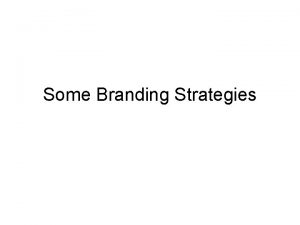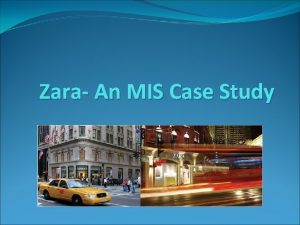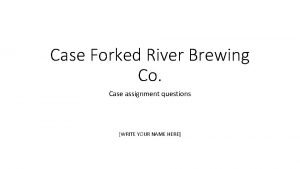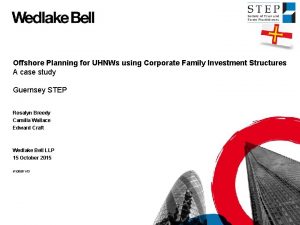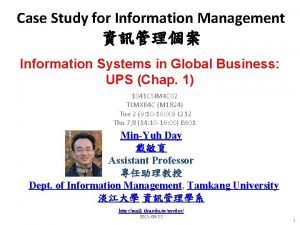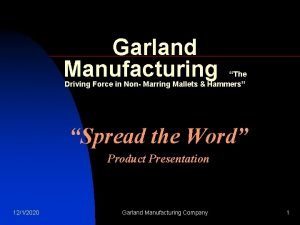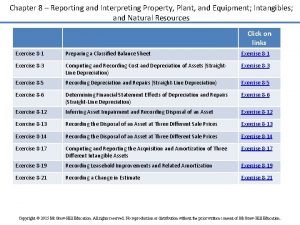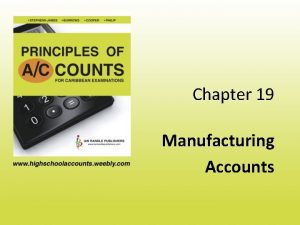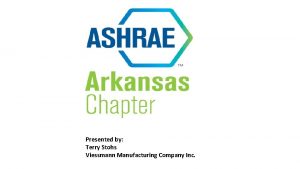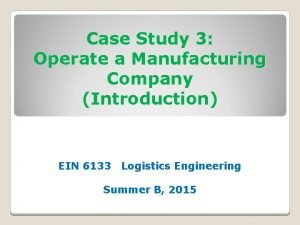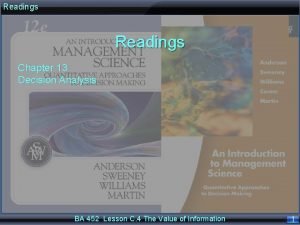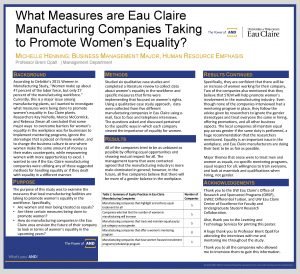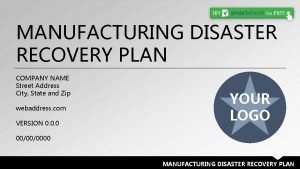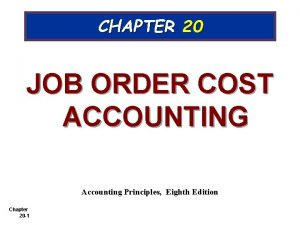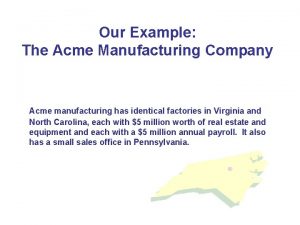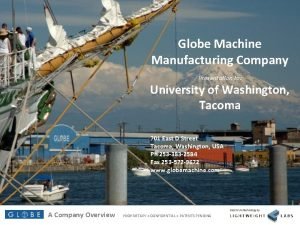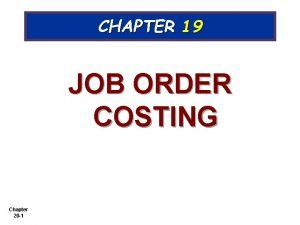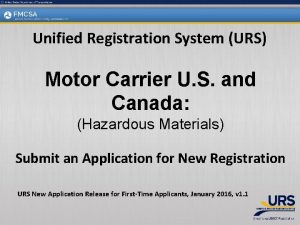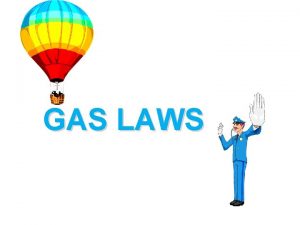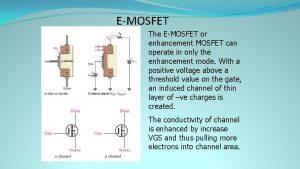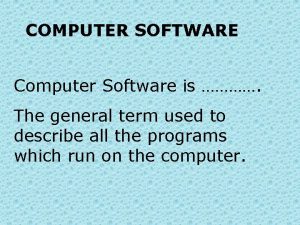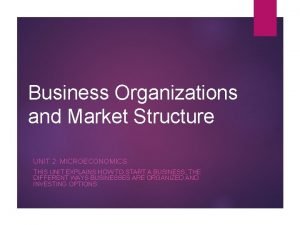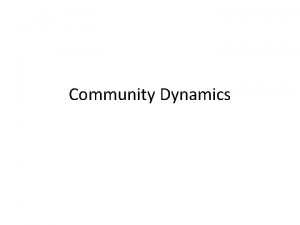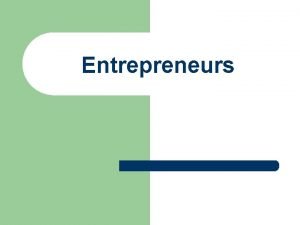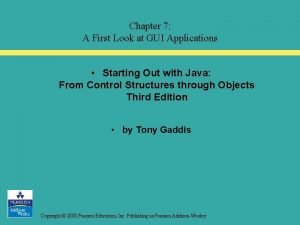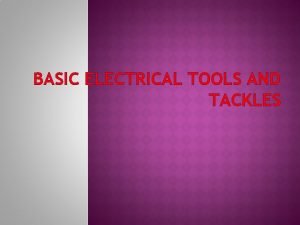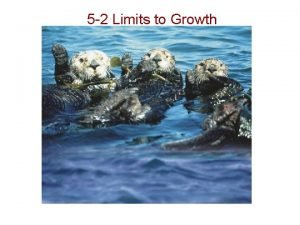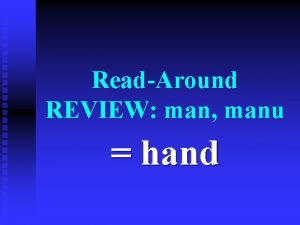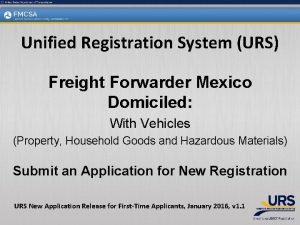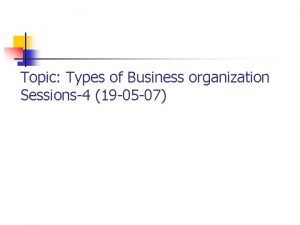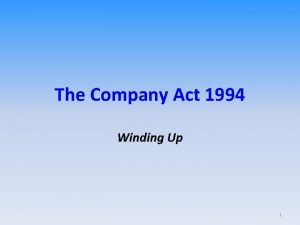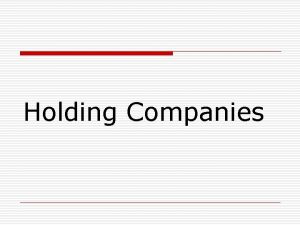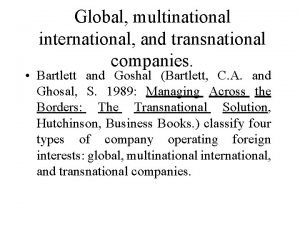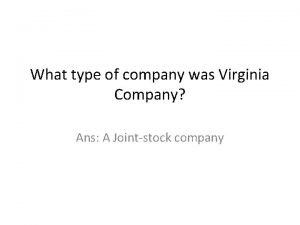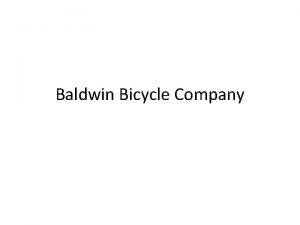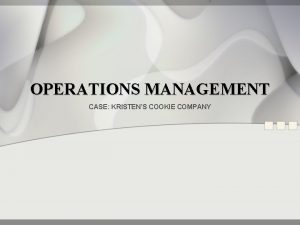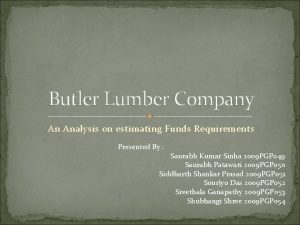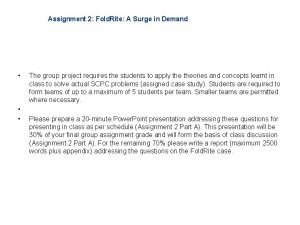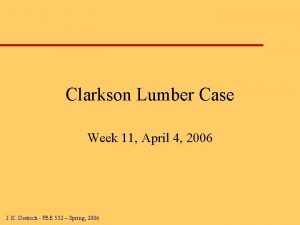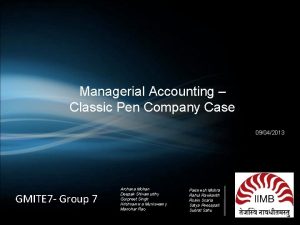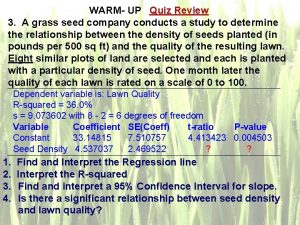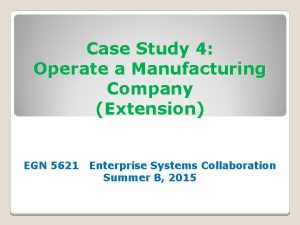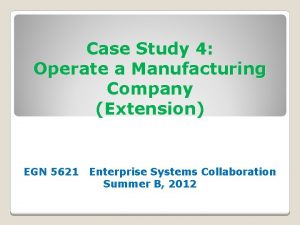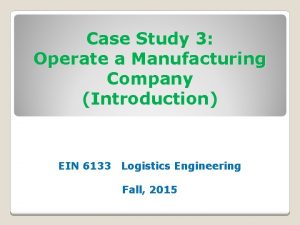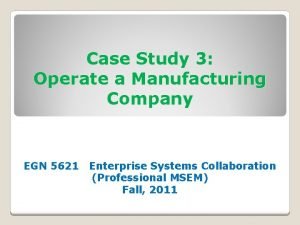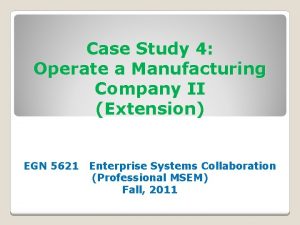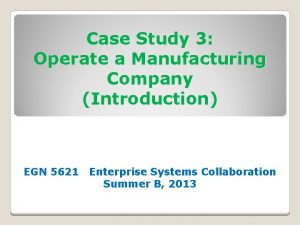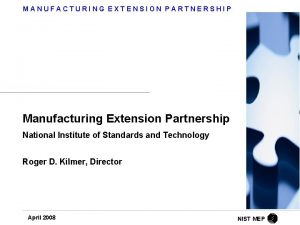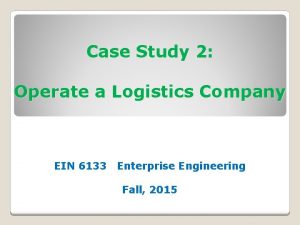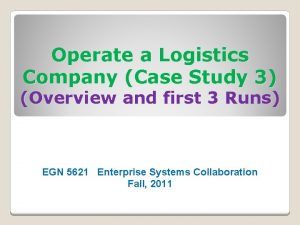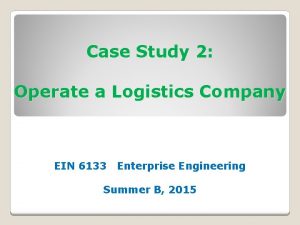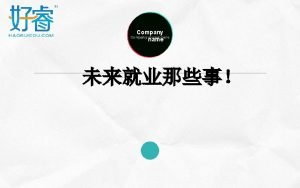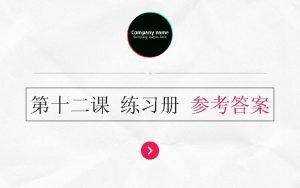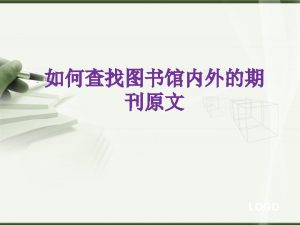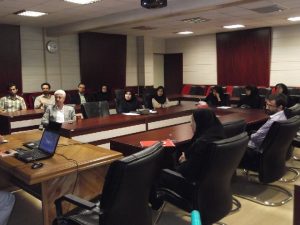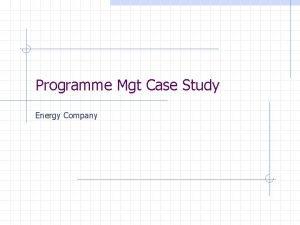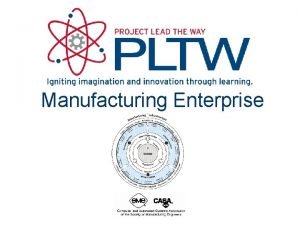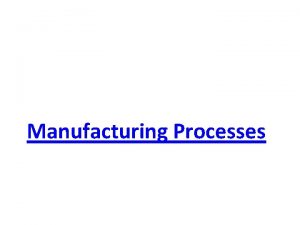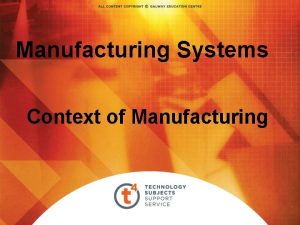Case Study 4 Operate a Manufacturing Company Extension



























































- Slides: 59

Case Study 4: Operate a Manufacturing Company (Extension) EGN 5621 Enterprise Systems Collaboration Fall, 2015

Rules of the Game § § § Each round will last for 30 steps End-of-round inventory is carried over to the next round You can sell a product only if you have it in stock You compete against the other teams and importers Your objective is to maximize profit

What’s New in Mfg Extension? Company can design own products based on specified rules, but the total number of products keeps six. 2. Besides 10, and 12, the distribution channel 14 is available. 3. Company can make investment to improve production capacity: 1. 1) Reduce set-up time 2) Increase production capacity 4. No starting inventory. Each company needs to do planning, run MRP, and convert purchase requisitions to POs before starting game.

What’s New in Mfg Extension? Depreciation of fixed assets is assessed 6. Fixed overheads are assessed 7. Inventory storage cost for excess stock is assessed 5.

Corporate Roles Designation CEO ◦ Check Financial Statement ◦ Make investment decisions for production ◦ Check summary sales report ◦ Check price market report Market & Sales Manager ◦ Check sales order report ◦ Check summary sales report ◦ Check price market report ◦ Maintain and change market expenditure ◦ Change selling prices for finished goods 5

Corporate Roles Designation Production and Planning Manager ◦ Create planned independent requirement ◦ Run MRP ◦ Release production orders ◦ Modify BOM ◦ Monitor production schedule ◦ Check product costs, including overhead costs ◦ Check raw materials cost per production order MM Manager ◦ Convert purchase requisitions to purchase orders ◦ Track PO report ◦ Check MRP results ◦ Check individual stock level ◦ Check inventory report 6

Tasks for the Manufacturing Case Study No Roles Functions 1 CEO 2 Sales & Marketing Manager 3 Watch financial statement Create GL Post (Investment) Check Price market report Check Summary sales report Check Sales order report Check Summary sales report Check Price market report Maintain marketing expense Maintain selling price for FG Create planned independent Requirements Production & Planning Manager Run MRP Convert planned orders to production orders Modify BOM Check production schedule Watch finished product cost analysis Check raw materials cost per Prod. order MM Manager Automatically generate POs from purchase requisitions Track Purchase order report Check MRP results Check individual stock level Check Inventory report 4 Transaction Code F. 01 FB 50 ZMarket ZVC 2 ZVA 05 ZVC 2 ZMarket ZADS VK 32 MD 61 MD 01 CO 41 ZCS 02 ZCOOIS ZCK 11 ZKSB 1 ME 59 N ZME 2 N MD 07 MD 04 ZMB 52

What’s New in Mfg Extension?

Muesli Manufacturing

Muesli Manufacturing

Muesli Manufacturing

1. Develop New Products 1) At beginning of the game, each company has six finished products with a preset recipe for each product. 2) You can change the recipe of a product from 1 kg to 0. 5 kg during the simulation by changing its bill of materials with Tcode ZCS 02. During simulation, your company always has six BOMs of finished products. 3) If your company still has inventory of the finished product, the system doesn’t allow you to change its BOM. 4) Your new product must meet the guideline for recipes. 5) When the system accepts your changes in BOM, it will change the description in the material master to match the new content and weight. 12

Muesli Manufacturing Association Label Regulation

List of Master Data Created for the Simulation Master Data Alphanumeric codes 6 Finished products $$-F 01 $$-F 02 $$-F 03 $$-F 04 $$-F 05 $$-F 06 6 Raw materials $$-R 01 $$-R 02 $$-R 03 $$-R 04 $$-R 05 $$-R 06 4 Packaging materials $$-P 01 $$-P 02 $$-P 03 $$-P 04 2 Vendors V 01 V 02 6 Bill of materials $$-F 01 $$-F 02 $$-F 03 $$-F 04 $$-F 05 $$-F 06 1 Work center $$ 6 Routings $$-F 01 $$-F 02 $$-F 03 $$-F 04 $$-F 05 $$-F 06 3 x 6 price lists (DC 10, 12, and 14) $$-F 01 $$-F 02 $$-F 03 $$-F 04 $$-F 05 $$-F 06 6 info-records and 6 source lists for raw materials V 01 -$$-R 01 V 01 -$$-R 02 V 01 -$$-R 03 V 01 -$$-R 04 V 01 -$$-R 05 V 01 -$$-R 06 4 info-records and 4 source lists for packaging materials V 02 -$$-P 01 V 02 -$$-P 02 V 02 -$$-P 03 V 04 -$$-P 04 1 profit center $$ 1 coster center $$

New Product Development (1/2)

New product development (2/2)

Change BOM for New Product (T-code ZCS 02) 17

Change BOM for New Product (Before change) 18

Change BOM for New Product (After Change) 19

2. Distribution Channels 20

DC 10: Hypermarkets (Review) Buy only large boxes (1 kg) Payment delay of 20 steps More sensitive to price Less sensitive to advertising Will have a stronger preference for 3 particular products during the simulation DC 12: Grocery Chains (Review) Buy both large boxes (1 kg) and small boxes (0. 5 kg) Payment delay of 10 to 15 steps Will have a stronger preference for 4 particular products during the simulation

Distribution Channel 14 Only buy small boxes (0. 5 kg) Less price sensitive Sensitive to advertising Payment delay of 5 to 15 steps Stronger preference for 2 particular products during the simulation 22

Number of Stores by Geographical Area

3. Investment for Production Capacity Improvement 24

3. Investment for Production Capacity Improvement 1) Reduce set-up time The default set-up time is 12 hours for changing product in your production line. If you want to keep product variety and wish to run small production batches, you can make investment to reduce the set-up time. The table below shows the set-up time as a function of your investment. If your investment is zero, the set-up time is 12 hours. If you invest 44, 117. 65, then the set-up time reduces to 10. 5 hours. 25

Investment for Reducing Set-up Time 26

Investment for Reducing Set-up Time

Special Investment for Reducing Set-up Time in the First Quarter • In the first quarter, every company must invest 5, 000 euros to reduce set-up time. • After the first investment, it is up to your company to decide whether to make further investment. 28

Investment in SAP to Reduce Set-up Time Use T-code: FB 50 G/L Account: 113300 (Weizen bank) D/C: credit Amount: 5, 000 (first investment) G/L Account: 478000 (Lean manufacturing expense) D/C: debit Amount: 5, 000 (first investment) Cost center: $$ 29

Investment for Reducing Set-up Time in SAP 30

Investment for Increasing Production Capacity • Your company can make investment on equipment to increase your production capacity. • This is a strategic decision for your operation. • At the start of simulation, your production equipment is worth of 5 million euros with the production capacity of producing 24, 000 boxes per day. 31

Increase Production Capacity For an additional machinery investment of 1, 000 euros you can increase production capacity by 1, 000 boxes per day. In order to obtain a daily capacity of 25, 000 boxes, you need to invest 1 million euros. Formula for capacity improvement: Total daily capacity = 24, 000 + (0. 001 x additional machinery investment). 32

Production Improvement Decision

Investment for Improving Production Capacity in SAP Use T-code: FB 50 G/L Account: 113300 (Weizen bank) D/C: credit Amount: Your investment G/L Account: 11000 (Machinery & equipment) D/C: debit Amount: Your investment 34

Investment to Improve Production Capacity in SAP 35

Difference between Investment for Reducing Set-up Time & Improving Production Capacity • Investment for reducing set-up time is a one shot investment as manufacturing expense. • Investment for improving production capacity is an investment to increase machinery assets. The annual depreciation of machinery assets is calculated as 10% of machinery value. 36


Initial Financial Statement

Pricing decision

Marketing decision

4. No Inventory at Beginning Each company needs to plan and complete the following steps before simulation: 1) - Planning for finished products (T-code: MD 61), 2) - Run MRP (T-code, MD 01), and 3) - Convert purchase requisitions to Purchase orders (T-code: ME 59 N) 4) - Convert planned orders to production order after raw and packing materials are available (T-code CO 41)

Create Planned Independent Requirement for 6 Finished Products (MD 61)

Create Planned Independent Requirement for 6 Finished Products (MD 61)

Execute MRP

Create Purchase Orders from Purchase Requisitions (ME 59 N)

Convert Purchase Requisitions into Purchase Orders

Convert Planned Orders to Production Orders After simulation is started and when required raw and packaging materials are received, the planning manager needs to convert planned orders to production orders (T-code: CO 41). You can release only those planned orders into production orders with which the required raw materials are available in your inventory.

Conversion of Planned Order (CO 41)

Release Production Order(s)

Release Production Orders (CO 41)

5. Depreciation of fixed assets is assessed (ZCK 11) Annual depreciation is calculated as 5% of building value and 10% of machinery value at 5 million Euros.

5. Depreciation of fixed assets is assessed (ZCK 11)

6. Fixed Mfg Overhead Fixed mfg overhead is assessed (T-code: ZCK 11)

7. Inventory Storage Cost

7. Inventory Storage Cost Each team has 2 warehouse storage areas: ◦ Finished product (02) - space for 250, 000 boxes ◦ Raw materials (88) - space for 250, 000 kg of raw materials and space for 1, 000 of boxes and bags Additional ◦ ◦ warehouse space can be rented for: 25, 000 boxes of finished products (or part thereof), @ € 250/day (€ 0. 01 per box per day) 25, 000 kg (or part thereof), @ € 500/step (more expensive because they are raw materials) 25, 000 boxes AND/OR bags (or part thereof), @ € 100/day. The cost of additional storage will be automatically billed, and paid immediately.

Raw Material Cost per PO

Game Layout 15 min 30 steps

Login Information: Server: MERIDA Client : 320 Login : $# run $ = Team Letter, A, B, C, D, E, F, G for pilot I , J, K, L, M, N, O, P for real run Password: # = User 1 ERPSIM to User 5

User Menu for Mfg Extension
 Acme manufacturing company case study
Acme manufacturing company case study Flanker brand strategy
Flanker brand strategy Manufacturing cost vs non manufacturing cost
Manufacturing cost vs non manufacturing cost Process costing definition
Process costing definition Controllable expenses examples
Controllable expenses examples Manufacturing cost vs non manufacturing cost
Manufacturing cost vs non manufacturing cost Additive manufacturing steps
Additive manufacturing steps Mis case study of any company
Mis case study of any company Forked river brewing company swot analysis
Forked river brewing company swot analysis Rbreedy
Rbreedy Amul company introduction
Amul company introduction Case study on management information system with the answer
Case study on management information system with the answer Disney company value
Disney company value Lincoln electric company case study
Lincoln electric company case study Best worst and average case
Best worst and average case Crm failure case study
Crm failure case study Defensive driving garland
Defensive driving garland Hulme company operates a small manufacturing facility
Hulme company operates a small manufacturing facility Manufacturing company accounts
Manufacturing company accounts Vanderman manufacturing company
Vanderman manufacturing company Viessmann fan coil
Viessmann fan coil Manufacturing company introduction
Manufacturing company introduction The gorman manufacturing company must decide
The gorman manufacturing company must decide Claire manufacturing company
Claire manufacturing company Disaster recovery plan for manufacturing company
Disaster recovery plan for manufacturing company Job order cost system
Job order cost system Acme manufacturing company
Acme manufacturing company Globe machine tools
Globe machine tools Marquis company estimates that annual manufacturing
Marquis company estimates that annual manufacturing Unified registration system urs
Unified registration system urs Unified registration system
Unified registration system How hot air balloons operate gas laws
How hot air balloons operate gas laws Emosfet
Emosfet General term for programs used to operate a computer
General term for programs used to operate a computer Business entities that operate in a duel market structure
Business entities that operate in a duel market structure Dynamics in the community
Dynamics in the community Contrasting international markets
Contrasting international markets Hand held computer
Hand held computer People who own, operate, and take the risk of a business
People who own, operate, and take the risk of a business Ethan can operate his camera with only one hand
Ethan can operate his camera with only one hand Programs that operate in a gui environment must be
Programs that operate in a gui environment must be Basic electrical tools and their uses
Basic electrical tools and their uses When do density-dependent operate most strongly
When do density-dependent operate most strongly Manu hand
Manu hand Non-cmvs the applicant plans to operate
Non-cmvs the applicant plans to operate Non-governmental health agencies are funded primarily by
Non-governmental health agencies are funded primarily by Partnership vs limited company
Partnership vs limited company Company act 1994
Company act 1994 Subsidiary company meaning
Subsidiary company meaning Transnational multinational global international
Transnational multinational global international What type of company was the virginia company
What type of company was the virginia company Ian giddy
Ian giddy Baldwin bicycle company
Baldwin bicycle company Kristen's cookie company
Kristen's cookie company Butler lumber company case solution
Butler lumber company case solution Foldrite
Foldrite Clarkson lumber company case
Clarkson lumber company case Gmite
Gmite A grass seed company conducts a study
A grass seed company conducts a study Long case vs short case
Long case vs short case

